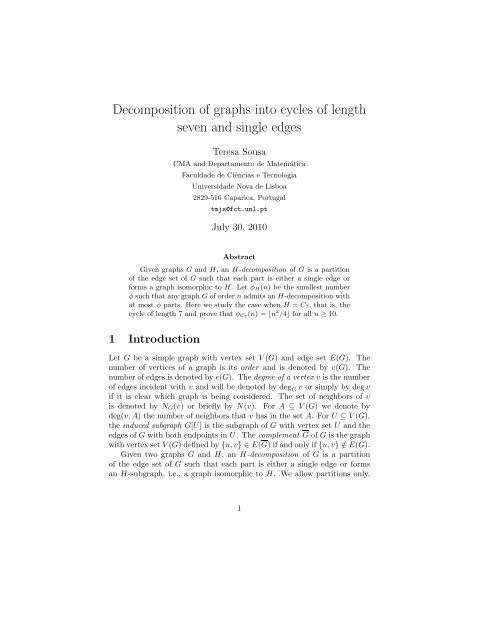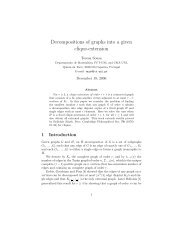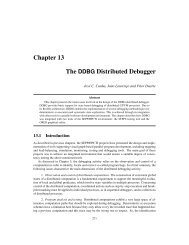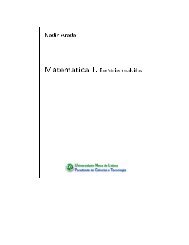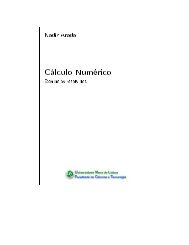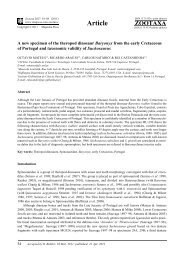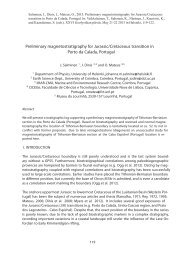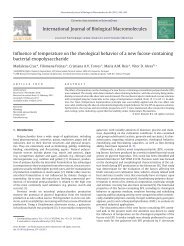Decomposition of graphs into cycles of length seven and single edges
Decomposition of graphs into cycles of length seven and single edges
Decomposition of graphs into cycles of length seven and single edges
Create successful ePaper yourself
Turn your PDF publications into a flip-book with our unique Google optimized e-Paper software.
<strong>Decomposition</strong> <strong>of</strong> <strong>graphs</strong> <strong>into</strong> <strong>cycles</strong> <strong>of</strong> <strong>length</strong><br />
<strong>seven</strong> <strong>and</strong> <strong>single</strong> <strong>edges</strong><br />
Teresa Sousa<br />
CMA <strong>and</strong> Departamento de Matemática<br />
FaculdadedeCiências e Tecnologia<br />
Universidade Nova de Lisboa<br />
2829-516 Caparica, Portugal<br />
tmjs@fct.unl.pt<br />
July 30, 2010<br />
Abstract<br />
Given <strong>graphs</strong> G <strong>and</strong> H, anH-decomposition <strong>of</strong> G is a partition<br />
<strong>of</strong>the<strong>edges</strong>et<strong>of</strong>Gsuch that each part is either a <strong>single</strong> edge or<br />
forms a graph isomorphic to H. Let φH(n) be the smallest number<br />
φ such that any graph G <strong>of</strong> order n admits an H-decomposition with<br />
at most φ parts. Here we study the case when H = C7, thatis,the<br />
cycle <strong>of</strong> <strong>length</strong> 7 <strong>and</strong> prove that φC7(n) =⌊n 2 /4⌋ for all n ≥ 10.<br />
1 Introduction<br />
Let G be a simple graph with vertex set V (G) <strong>and</strong><strong>edges</strong>etE(G). The<br />
number <strong>of</strong> vertices <strong>of</strong> a graph is its order <strong>and</strong> is denoted by v(G). The<br />
number <strong>of</strong> <strong>edges</strong> is denoted by e(G). The degree <strong>of</strong> a vertex v is the number<br />
<strong>of</strong> <strong>edges</strong> incident with v <strong>and</strong> will be denoted by deg G v or simply by deg v<br />
if it is clear which graph is being considered. The set <strong>of</strong> neighbors <strong>of</strong> v<br />
is denoted by NG(v) orbrieflybyN(v). For A ⊆ V (G) wedenoteby<br />
deg(v, A) the number <strong>of</strong> neighbors that v has in the set A. ForU ⊆ V (G),<br />
the induced subgraph G[U] is the subgraph <strong>of</strong> G with vertex set U <strong>and</strong> the<br />
<strong>edges</strong> <strong>of</strong> G with both endpoints in U. Thecomplement G <strong>of</strong> G is the graph<br />
with vertex set V (G) defined by {u, v} ∈E(G) if <strong>and</strong> only if {u, v} /∈ E(G).<br />
Given two <strong>graphs</strong> G <strong>and</strong> H, anH-decomposition <strong>of</strong> G is a partition<br />
<strong>of</strong>the<strong>edges</strong>et<strong>of</strong>G such that each part is either a <strong>single</strong> edge or forms<br />
an H-subgraph, i.e., a graph isomorphic to H. We allow partitions only,<br />
1
that is, every edge <strong>of</strong> G appears in precisely one part. Let φH(G) bethe<br />
smallest possible number <strong>of</strong> parts in an H-decomposition <strong>of</strong> G.<br />
It is easy to see that, for non-empty H, φH(G) =e(G) − pH(G)(e(H) −<br />
1), where pH(G) is the maximum number <strong>of</strong> pairwise edge-disjoint Hsub<strong>graphs</strong><br />
that can be packed <strong>into</strong> G. Building upon a body <strong>of</strong> previous<br />
research, Dor <strong>and</strong> Tarsi [3] showed that if H has a component with at least<br />
3 <strong>edges</strong> then the problem <strong>of</strong> checking whether an input graph G is perfectly<br />
decomposable <strong>into</strong> H-sub<strong>graphs</strong> is NP-complete. Hence, it is NP-hard to<br />
compute the function φH(G) forsuchH.<br />
Here we study the function<br />
φH(n) =max{φH(G) | v(G) =n},<br />
which is the smallest number such that any graph G <strong>of</strong> order n admits an<br />
H-decomposition with at most φH(n) parts. Motivated by the problem<br />
<strong>of</strong> representing <strong>graphs</strong> by set intersections, Erdös, Goodman <strong>and</strong> Pósa [4]<br />
proved that φK3(n) =t2(n), where Kr denotes the complete graph (clique)<br />
<strong>of</strong> order r, <strong>and</strong>tr(n) is the maximum number <strong>of</strong> <strong>edges</strong> in an r-partite graph<br />
on n vertices. This result was extended by Bollobás [1], who proved that<br />
φKr(n) =tr−1(n), for all n ≥ r ≥ 4.<br />
In general, for any fixed graph H the exact value <strong>of</strong> the function φH(n)is<br />
still unknown. However, Pikhurko <strong>and</strong> Sousa [5] determined the asymptotic<br />
<strong>of</strong> φH(n) for any fixed graph H as n tends to infinity. In particular, for a<br />
non-bipartite graph H they proved the following.<br />
Theorem 1.1. Let H be any fixed graph with chromatic number r ≥ 3.<br />
Then,<br />
φH(n) =tr−1(n)+o(n 2 ).<br />
Therefore,<br />
2 n<br />
φC2t+1(n) = + o(n<br />
4<br />
2 ),<br />
where C2t+1 denotes the odd cycle on 2t + 1 vertices, for t ≥ 1.<br />
Unfortunately, for t ≥ 4 the exact value <strong>of</strong> the function φC2t+1(n) is still<br />
unknown. The author [6] proved that<br />
2 n<br />
φC5(n) = , for all n ≥ 6.<br />
4<br />
Using the same ideas as in [6] we can determine the exact value <strong>of</strong> the<br />
function φC7(n) for all n ≥ 10. Unfortunately, it seems difficult to extend<br />
this method to give us the exact value <strong>of</strong> the function φC2t+1(n) for all<br />
t ≥ 4. We prove the following theorem.<br />
2
Theorem 1.2.<br />
2 n<br />
φC7(n) = , for all n ≥ 10.<br />
4<br />
The upper bound will be proved in Section 2 <strong>and</strong> the lower bound<br />
follows from the trivial inequality<br />
2 n<br />
,<br />
φC7(n) ≥ φC7(K n n ⌊ 2 ⌋,⌈ 2 ⌉)=<br />
where Kt,s denotes the complete bipartite graph with parts <strong>of</strong> size t <strong>and</strong> s.<br />
2 Pro<strong>of</strong> <strong>of</strong> Theorem 1.2<br />
In this section we prove the upper bound <strong>of</strong> Theorem 1.2. Before presenting<br />
the pro<strong>of</strong> we need to state <strong>and</strong> prove some results that will be needed later.<br />
The first observation is that the complete graph on 7 vertices contains 3<br />
edge disjoint C7’s (see Figure 1).<br />
Figure 1: K7 <strong>and</strong> the 3 edge disjoint C7’s.<br />
Recall that the Turán function, denoted by ex(n, H), is the maximum<br />
number <strong>of</strong> <strong>edges</strong> that a graph on n vertices can have without containing H<br />
as a subgraph.<br />
The following result was obtained by Yang Yuansheng using the same<br />
computer algorithm as in [7].<br />
Lemma 2.3. ex(10,C7) =25<strong>and</strong> the only <strong>graphs</strong> with 10 vertices, 25<br />
<strong>edges</strong> <strong>and</strong> no copy <strong>of</strong> C7 are the complete bipartite graph K5,5 <strong>and</strong> a K5<br />
plus a K6 sharing a vertex, denoted by K5 • K6.<br />
3<br />
4
Lemma 2.4. φC7(10) = 25.<br />
Pro<strong>of</strong>. The lower bound follows from φC7(10) ≥ ex(10,C7) = 25. We will<br />
now prove the upper bound. Let G be a graph with 10 vertices. Our aim<br />
is to prove that φC7(G) ≤ 25. We have to consider a few cases.<br />
If e(G) ≤ 25 then it suffices to decompose G <strong>into</strong> <strong>single</strong> <strong>edges</strong>.<br />
Assume 26 ≤ e(G) ≤ 43. Suppose first that e(G) = 32, 38, 39. The<br />
upper bound follows since we can greedily remove copies <strong>of</strong> C7 <strong>and</strong> then<br />
remove the remaining <strong>edges</strong>. Suppose e(G) =32(resp. e(G) = 39) <strong>and</strong><br />
suppose that G contains exactly one C7 (resp. two C7’s). Let G ∗ be<br />
the graph obtained from G after deleting the <strong>edges</strong> <strong>of</strong> the C7(’s). Then,<br />
e(G ∗ ) = 25 <strong>and</strong> G ∗ contains no C7. By Lemma 2.3 G ∗ is either K5,5 or<br />
K5 • K6. Therefore, the complement <strong>of</strong> G ∗ must contain a C7, which is a<br />
contradiction since the complement <strong>of</strong> G ∗ is either K4,5 or 2 vertex disjoint<br />
K5’s. Therefore, G contains at least two (resp. three) edge-disjoint C7’s<br />
<strong>and</strong> the result follows.<br />
Consider the case e(G) = 38. It suffices to find 3 edge disjoint C7’s in<br />
G. ThisistrueifG contains a K7 (see Figure 1). Since e(G) ≥ t4(10) = 37<br />
it follows that G contains a K5. We now have to consider two cases.<br />
Case 1: G contains a K6 <strong>and</strong> no K7.<br />
Let V (K6) ={1, 2, 3, 4, 5, 6} <strong>and</strong> A = V (G) − V (K6). Observe that<br />
deg(y, V (K6)) ≤ 5 for all y ∈ A, sinceG contains no K7. Then, e(G[A]) ≥<br />
3. Suppose first that e(G[A]) = 3, then deg(y, V (K6)) = 5 for all y ∈ A.<br />
Let y1 <strong>and</strong> y2 be adjacent vertices in G[A] <strong>and</strong> suppose that y1 is adjacent<br />
to 1, 2, 3, 4, 5. Then,<br />
y1, 2, 1, 6, 5, 4, 3,y1 <strong>and</strong> y1, 1, 3, 5, 2, 6, 4,y1<br />
form two edge disjoint C7’s. If the vertex y2 is adjacent to 3 we have<br />
y1, 5, 1, 4, 2, 3,y2,y1, otherwisewehavey2, 5, 1, 4, 2, 3, 6,y2. We have found<br />
3 edge disjoint C7’s as wanted.<br />
Assume that e(G[A]) = 4. Then, there are y1,y2,y3 ∈ A such that<br />
deg(yi,V(K6)) = 5 for all i =1, 2, 3. Without loss <strong>of</strong> generality assume y1<br />
<strong>and</strong> y2 are adjacent in G[A] <strong>and</strong> the result holds as before.<br />
Finally, suppose e(G[A]) ≥ 5. Then, there are y1,y2 ∈ A such that y1<br />
is adjacent to y2, deg(y1,V(K6)) = 5 <strong>and</strong> deg(y2,V(K6)) ≥ 4. In this case<br />
G[A] iseitheraK4 or a K4 minus one edge <strong>and</strong> since y1 is adjacent to y2,<br />
it follows that the edge y1y2 belongs to a C4 in G[A]. Let y1 be adjacent to<br />
1, 2, 3, 4, 5. Since y1 <strong>and</strong> y2 must have at least 3 common neighbors in K6,<br />
we can assume, without loss <strong>of</strong> generality, that y2 is adjacent to vertices<br />
1, 2, 3<strong>of</strong>K6. Then, Figure 2 shows that G contains 3 edge disjoint C7’s as<br />
required.<br />
Case 2: G contains a K5 <strong>and</strong> no K6.<br />
4
6<br />
5<br />
1<br />
4<br />
2<br />
3<br />
Figure 2: e(G[A]) ≥ 5.<br />
Let V (K5) ={1, 2, 3, 4, 5} <strong>and</strong> let A = V (G) − V (K5). Observe that<br />
deg(y, V (K5)) ≤ 4 for all y ∈ A, since G contains no K6. Therefore,<br />
e(G[A]) ≥ 8. Suppose first that e(G[A]) = 8, then deg(y, V (K5)) = 4 for<br />
all y ∈ A <strong>and</strong> there are only two possible <strong>graphs</strong> G[A]. Let y1 <strong>and</strong> y2 be<br />
adjacent vertices in G[A] such that deg G[A](y1) = 4 <strong>and</strong> deg G[A](y2) =3.<br />
Without loss <strong>of</strong> generality let y1 beadjacentto1,2,3,4.Ify1 <strong>and</strong> y2 have<br />
at least 3 common neighbors in V (K5), say 1,2,3, then Figure 3 shows that<br />
G contains 3 edge disjoint C7’s for the two possible <strong>graphs</strong> G[A]. Otherwise,<br />
y2 is adjacent to 1, 2, 4, 5 or to 1, 3, 4, 5. Suppose the first case holds, the<br />
second follows by symmetry. Then, Figure 3 holds with y1, 2, 1, 4, 5, 3,y2,y1<br />
replaced by y1, 2, 1, 4, 3, 5,y2,y1.<br />
If e(G[A]) = 9, then there are vertices y1,y2,y3,y4 ∈ A such that<br />
deg(yi,V(K5)) = 4 for i =1, 2, 3, 4. A similar case analysis shows that<br />
the results obtained in Figure 3 also hold. Let e(G[A]) = 10. Thus, there<br />
exist y1,y2 ∈ A such that deg(yi,V(K5)) = 4 for i =1, 2 <strong>and</strong> we are done<br />
as before.<br />
To finish the pro<strong>of</strong> suppose e(G) = 44 or e(G) = 45. Then, we can easily<br />
find 4 edge disjoint C7’s in G. LetV (G) ={v, y, v1,v2,v3,v4,x1,x2,x3,x4}<br />
<strong>and</strong> without loss <strong>of</strong> generality we can suppose that the edge {v, y} is not<br />
present if G = K10. Then, for i =1, 2, 3, 4 with indices taken cyclically,<br />
are 4 <strong>edges</strong> edge disjoint C7’s in G.<br />
y1<br />
y2<br />
v, vi,xi,y,vi+1,xi+2,xi+3,v<br />
We are now able to prove the upper bound in Theorem 1.2.<br />
5
5<br />
4<br />
1<br />
2<br />
3<br />
(i)<br />
y2<br />
y1<br />
Figure 3: e(G[A]) = 8.<br />
Pro<strong>of</strong> <strong>of</strong> the upper bound in Theorem 1.2. By induction on the number <strong>of</strong><br />
vertices. Lemma 2.4 proves the result for n = 10. Assume that it is true<br />
for all <strong>graphs</strong> <strong>of</strong> order n − 1 <strong>and</strong> note that for any positive integer n<br />
<br />
2<br />
2<br />
n (n − 1)<br />
<br />
n<br />
<br />
=<br />
+ .<br />
4 4 2<br />
Let G be a graph <strong>of</strong> order n ≥ 11. Let v be a vertex <strong>of</strong> minimum<br />
degree, say deg v = d + m where d = <br />
n<br />
2 <strong>and</strong> m is an integer. If m ≤ 0<br />
then going from G − v to G we only need to use the <strong>edges</strong> joining v to the<br />
other vertices <strong>of</strong> G <strong>and</strong> there are at most <br />
n<br />
2 <strong>of</strong> these, so the induction<br />
hypothesis implies the result.<br />
Let m ≥ 1. If there are m edge disjoint C7’s containing v, then the d+m<br />
<strong>edges</strong> incident with v can be decomposed <strong>into</strong> at most m+(d+m−2m) =d<br />
edge disjoint C7’s <strong>and</strong> <strong>single</strong> <strong>edges</strong> <strong>and</strong> the result follows by induction. To<br />
complete the pro<strong>of</strong>, it remains to show that we can always find m edge<br />
disjoint C7’s containing v.<br />
Assume first that G is not the complete graph. Recall that deg(y, X)<br />
denotes the number <strong>of</strong> neighbors that y has in the set X. Let x ∈ N(v)<br />
<strong>and</strong> y ∈ N(v), where N(v) :=V (G) − (N(v) ∪{v}). We have<br />
(ii)<br />
deg(x, N(v)) ≥ 2m − 1, (2.1)<br />
deg(y, N(v)) ≥ 2m +1. (2.2)<br />
Let x1,...xm ∈ N(y) ∩ N(v), X = {x1,...xm} <strong>and</strong> Y = N(v) − X.<br />
Consider the bipartite graph G[X, Y ] with bipartition (X, Y ) <strong>and</strong> all the<br />
<strong>edges</strong> <strong>of</strong> G between X <strong>and</strong> Y . Using(2.1)itiseasytoseethatG[X, Y ]<br />
has an X-perfect matching, say M = {xi,vi}i=1,...,m.<br />
6<br />
y1<br />
y2
We first consider the case when N(v) contains another element different<br />
from y, callity ′ . Observe that δ(G) ≥ d + m easily implies the following<br />
claim.<br />
Claim 1. Let y, y ′ ∈ N(v). Then, y <strong>and</strong> y ′ have at least 2m common<br />
neighbors if they are adjacent <strong>and</strong> at least 2m +2 otherwise.<br />
Without loss <strong>of</strong> generality we assume that xj1,...,xjt <strong>and</strong> v1,...,vℓ are<br />
common neighbors <strong>of</strong> y <strong>and</strong> y ′ ,wheret <strong>and</strong> ℓ integers between 0 <strong>and</strong> m.<br />
Let aℓ+1,...,am be elements in (N(y)∩N(y ′ ))−{xj1,...,xjt,v1,...,vℓ},<br />
which exist in view <strong>of</strong> Claim 1 <strong>and</strong> the fact that m ≥ t. Letwjt+1,...,wjm ∈<br />
(N(y ′ ) ∩ N(v)) −{xj1,...,xjt,v1,...,vℓ,aℓ+1,...,am}, which exist in view<br />
<strong>of</strong> (2.2). For i ∈{1,...,m}, we define wi = xi whenever y ′ is adjacent to<br />
xi, <strong>and</strong> for the sake <strong>of</strong> simplicity we relabel the vertices wjt+1,...,wjm so<br />
that we have a set <strong>of</strong> vertices w1,...wm. For1≤ j ≤ ℓ we set aj := vj.<br />
Finally, for 1 ≤ i ≤ m, with indices taken cyclically,<br />
v, vi,xi,y,ai+1,y ′ ,wi+1,v<br />
are m edge disjoint C7’s, if m ≥ 2.<br />
Let m =1. Then|N(v)| ≥3. Assume first that y <strong>and</strong> y ′ are nonadjacent<br />
vertices. By Claim 1 there are a1,a2 ∈ N(y ′ ) ∩ N(y) −{v1,x1}.<br />
If there is w ∈ N(y ′ ) ∩ N(v) −{x1,v1,a1} then v, v1,x1,y,a1,y ′ ,w,v is<br />
a C7. Otherwise, N(y ′ ) ∩ N(v) ={x1,v1,a1}, a1 ∈ N(v) <strong>and</strong> we have<br />
v, v1,x1,y,a2,y ′ ,a1,v. Now assume that all vertices in N(v) arepairwise<br />
adjacent. Let y, y ′ ,y ′′ ∈ N(v) <strong>and</strong>w ∈ N(y ′′ ) ∩ N(v) −{x1,v1}, then<br />
v, v1,x1,y,y ′ ,y ′′ ,w,v is a C7.<br />
Suppose that y is the only element in N(v). Then, y is adjacent<br />
to all vertices in N(v) <strong>and</strong> m ≥ 4. Let z be an element in N(v) −<br />
{x1,...,xm,v1,...,vm}. Sinceδ(G) =n − 2 it follows that z must have at<br />
least 2m−1 neighborsin{x1,...,xm,v1,...,vm}, so without loss <strong>of</strong> generality<br />
we assume that z is adjacent to every vertex in {x1,...,xm,v1,...,vm}<br />
except perhaps xm. Again because <strong>of</strong> the minimum degree constraint there<br />
is a ∈ (N(xm) ∩ N(vm)) −{v, v1,z,y}. Therefore, for 1 ≤ i ≤ m − 2,<br />
v, vi,xi,y,vi+1,z,xi+1,v<br />
are m − 2 edge disjoint C7’s, that together with<br />
v, vm−1,xm−1,y,vm,z,x1,v<br />
v, vm,a,xm,y,v1,z,v<br />
form m edge disjoint C7’s.<br />
To conclude the pro<strong>of</strong> <strong>of</strong> the theorem it remains to consider the case<br />
G = Kn. Recall that our goal it to find m edge disjoint C7’s incident with<br />
v.<br />
7
Let n be even <strong>and</strong> v, y, x1,...,xm,v1,...,vm be the vertices <strong>of</strong> G. Then,<br />
for i =1,...,m, with indices taken cyclically,<br />
v, vi,xi,y,vi+1,xi+2,xi+3,v,<br />
are m <strong>edges</strong> disjoint C7’s since m ≥ 5.<br />
Let n be odd <strong>and</strong> v, y, x1,...,xm,v1,...,vm−1 be the vertices <strong>of</strong> G.<br />
Consider first the case m ≥ 6, that is n ≥ 13. Then, for i =1,...,m− 2,<br />
with indices taken cyclically,<br />
together with<br />
are m edge disjoint C7’s.<br />
If n =11thenm =5<strong>and</strong><br />
are 5 edge disjoint C7’s.<br />
v, vi,xi,y,vi+1,xi+2,xi+3,v,<br />
v, vm−1,vm−2,vm−3,xm−1,y,xm,v<br />
v, xm−1,xm−4,vm−3,vm−4,vm−1,y,v<br />
v, v1,x1,y,v2,x3,x4,v<br />
v, v2,x2,y,v3,x4,x5,v<br />
v, v3,x3,y,v4,x5,x1,v<br />
v, v4,x4,y,v1,v3,x2,v<br />
v, x3,v4,v3,v2,x5,y,v<br />
Remark: Let Kp • Kt denote a Kp plus a Kp sharingavertex. For<br />
n =7, 8, 9 the <strong>graphs</strong> K6 • K2, K6 • K3 <strong>and</strong> K6 • K4 show that n =2, 10<br />
are the smallest values <strong>of</strong> n for which Theorem 1.2 holds.<br />
Acknowledgement. The author thanks Oleg Pikhurko for helpful discussions<br />
<strong>and</strong> comments <strong>and</strong> Yang Yuansheng for proving the results stated in<br />
Lemma 2.3.<br />
References<br />
[1] B. Bollobás. On complete sub<strong>graphs</strong> <strong>of</strong> different orders. Math. Proc.<br />
Cambridge Philos. Soc., 79(1):19–24, 1976.<br />
[2] R. Diestel. Graph Theory. Springer–Verlag, 2nd edition, 2000.<br />
8
[3] D. Dor <strong>and</strong> M. Tarsi. Graph decomposition is NP-complete: a complete<br />
pro<strong>of</strong> <strong>of</strong> Holyer’s conjecture. SIAM J. Comput., 26(4):1166–1187, 1997.<br />
[4] P. Erdös, A. W. Goodman, <strong>and</strong> L. Pósa. The representation <strong>of</strong> a graph<br />
by set intersections. Canad. J. Math., 18:106–112, 1966.<br />
[5] O. Pikhurko <strong>and</strong> T. Sousa. Minimum H-decompositions <strong>of</strong> <strong>graphs</strong>.<br />
Journal <strong>of</strong> Combinatorial Theory, B, 97:1041–1055, 2007.<br />
[6] T. Sousa. <strong>Decomposition</strong>s <strong>of</strong> <strong>graphs</strong> <strong>into</strong> 5-<strong>cycles</strong> <strong>and</strong> other small<br />
<strong>graphs</strong>. Electronic Journal <strong>of</strong> Combinatorics, 12:R49, 7 pp., 2005.<br />
[7] Y. S. Yang <strong>and</strong> P. Rowlinson. On <strong>graphs</strong> without 6-<strong>cycles</strong> <strong>and</strong> related<br />
Ramsey numbers. Utilitas Math., 44:192–196, 1993.<br />
9


